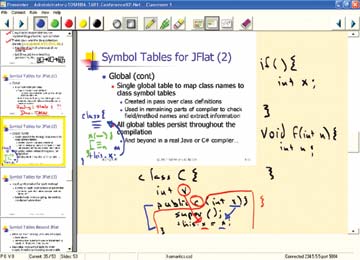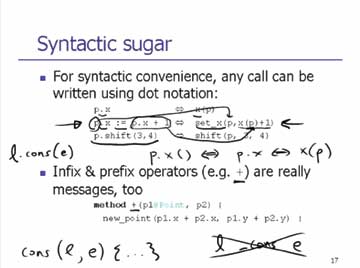Beyond PowerPoint: Building a New Classroom Presenter
- By Richard Anderson
- 06/01/04
 “… in the winter of 1813 & ’14 , during my first College vacations, I attended a mathematical school kept in Boston by the Rev. Francis Xavier Brosius . . . On entering his room, we were struck at the appearance of an ample Black Board suspended on the wall, with lumps of chalk on a ledge below, and cloths hanging at either side. I had never heard of such a thing before. There it was—forty-two years ago—that I first saw what now I trust is considered indispensable in every school—the Black Board—and there that I first witnessed the process of analytical and inductive teaching.” [May 1855]
“… in the winter of 1813 & ’14 , during my first College vacations, I attended a mathematical school kept in Boston by the Rev. Francis Xavier Brosius . . . On entering his room, we were struck at the appearance of an ample Black Board suspended on the wall, with lumps of chalk on a ledge below, and cloths hanging at either side. I had never heard of such a thing before. There it was—forty-two years ago—that I first saw what now I trust is considered indispensable in every school—the Black Board—and there that I first witnessed the process of analytical and inductive teaching.” [May 1855]
Presentation technology has long had an influence on how we teach. In the wonderful quote above, the abolitionist Samuel J. May described his introduction to the blackboard and its impact on teaching. The quote illustrates a couple of key points: That technology has an important role in supporting classroom instruction, and that technologies perceived as beneficial to instruction will become widely adopted. The blackboard is a very powerful tool for instruction—it allows information to be displayed in a persistent manner, and can give the audience a consistent view of far more information than can be held in short-term memory. The blackboard becomes a mediating artifact that maintains a shared view between the instructor and students to provide context for lecture and discussion.
Stepping forward almost two centuries from Samuel May’s visit to Boston, projected electronic slides are becoming an important presentation tool in the classroom. There are some significant advantages to using electronic slides. Slides allow advanced preparation of material, improving organization of the presentation and giving a means of showing information-rich content such as complex tables, formulas, programs, and diagrams. Slides afford instantaneous display, avoiding the inaccuracy and the time of copying material onto an overhead projector or whiteboard. Electronic slides offer the further advantage of not having to print slides. Additional advantages of online materials include ease of preparation, sharing, and modification.
undefined
However, these advantages come at a cost in the classroom. Both students and instructors complain about the impact of using slides in lecture. One colleague expressed this directly as, “PowerPoint sucks the life out of a class.” The basic issue is that electronic slides tend to script a lecture and do not provide mechanisms to adapt the presentation to the audience. An important part of lecturing is adjusting material in response to audience reactions and developing spontaneous examples and explanations to clarify and expand on topics. The weakness of electronic projection of slides is the absence of a means to alter or augment the displayed material to do this.
Breathing Life into Classroom Presentations
At the University of Washington, we developed Classroom Presenter specifically to address this problem, and to provide flexibility while using slides. The idea behind Classroom Presenter is simple: support writing on top of slides by using the Tablet PC as the instructor device.
undefined
When lecturing using Classroom Presenter the instructor writes on top of images of the slides. These images can either be projected directly from the Tablet PC, or can be shown from a second machine that is networked to the first. An advantage of the latter configuration is that the instructor can be untethered from the projector, and lecture while holding the Tablet PC. The networked version also lends itself to use in distance courses. The single machine version has the advantage of being easier to set up. Figure 1 shows the instructor view, and Figure 2 shows the view displayed on the data projector.
A key part of our system is the use of the Tablet PC as the instructor device. Tablet PCs enable integration of ink with slides, allowing annotation with natural handwriting. The high-quality ink of the Tablet PC completely changes the writing experience from earlier pen computers based on different technologies. (Our system is not unique in combining slides and digital ink using the Tablet PC; an increasing number of other systems combine slides and digital ink using the Tablet PC, including academic systems such as DyKnow, and commercial applications such as PowerPoint and Journal.)
In developing the application, we paid attention to the display of ink on all devices, so that remote displays’ ink flows in sync with the instructor’s, communicating the direction and speed of writing. A substantial amount of effort went into designing the system as a tablet application. This meant using controls optimized for pen manipulation in a mobile environment. We also designed the system with navigation facilities such as the film strip and direct navigation to a whiteboard.
Classroom Presenter has been used in a wide range of Computer Science courses at UW and other universities. Courses have included introductory programming, data structures, software engineering, and computer architecture. Both instructors and students have been very positive about the system. Typical instructor comments include: “It didn’t take any adaptation. I just talked/ discussed and when I needed an example, I wrote. As easy as using the board,” and “Being able to diagram and spontaneously work examples instead of having to use a pre-scripted PowerPoint slide deck—felt like teaching a real class.”

Figure 1: Instructor view with navigation and pen controls. The slide size has been reduced to provide the instructor with extra annotation area.

Figure 2: Projector view showing only the slide. The Projector view is synchronized with Figure 1’s instructor view.
Connecting with Student Devices
As one would expect, instructors have made varied use of the system. Some instructors have made extensive use of ink on slides, while others have retained a slide-based style with only occasional marking.undefinedIn presentation, ink is used both to convey information directly with text and diagrams, and to link speech to slides through attentional markings. Figures 3 and 4 show examples of usage from actual classes. In both of these examples the meaning of the writing was dependent on the spoken context and is not conveyed in the static image. Digital ink has allowed instructors to conduct many activities not supported by electronic slides alone, such as a “collective brainstorming,” where answers that students speak out are written down and “process simulation,” where ink is used on top of a diagram to show a dynamic process. It has been observed that ink is often used when responding to student questions. This supports the view that the value of ink is in supporting spontaneous acts by the instructor. One interesting pattern of use of ink that has been observed across instructors is frequent underlining and circling when talking about mathematical formulae or program code, as in Figure 3. This is done to give a persistent tie between speech and slide content. Another important use of ink is to repurpose slide content, such as changing an example on a slide to make it cover a different situation.

Figure 3: Example of writing from classroom use showing how an instructor works with formulas during presentation.

Figure 4: Example showing multiple diagrams on slides used in explanation of the formula.
Classroom Presenter is just the first step in using electronic materials in the classroom. The current work on Classroom Presenter is to expand its interaction with student devices. One natural direction is note-taking, where the ink and slides are broadcast to note-taking applications such as Brown University’s Remarkable Texts, Microsoft’s OneNote, or the Classroom Presenter so that the student can take notes on top of the instructor’s ink and slides. Another direction is to provide mechanisms for the instructor to direct student activities. One example that Classroom Presenter supports is student contribution of slides. In this case, students write on slides on personal devices and send them back to the instructor. The instructor then chooses student submissions to display for class discussion. This activity has a number of benefits. It engages the students by giving them an activity to perform in class, instead of just listening to the instructor. It allows the instructor the opportunity to screen submissions before displaying them, to choose ones that illustrate different approaches. And it supports “going to the whiteboard” in a way that everyone can contribute.
[Editor’s note: The development of Classroom Presenter began when the author was on sabbatical at Microsoft Research working with the ConferenceXP Project (www.conferencexp. net). The work is now being conducted at University of Washington, with collaborators at University of Virginia and University of San Diego. The software is available for non-commercial use from www.cs.washington.edu/education/dl/presenter/.]
About the Author
Richard Anderson ([email protected]) is a professor in the Department
of Computer Science and Engineering at the University of Washington.